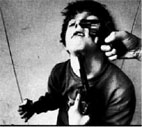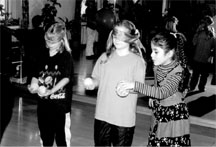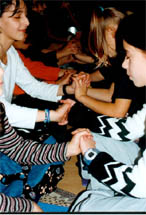|
Needs: As result of alienation and exclusion by social and ethnic reasons post modern societies suffer from auto-aggression and violence towards individuals and groups especially by children and teenagers.
|
 |
|
|
Objectives: Aesthetic education through the body can develop personality and perception, which allows people to experience separation as a form of variety against the background of a fundamental sense of community. By the development of creativity and a personal scale of responsibility, individual and group differences could be experienced without assessment not as thread but cultural wealth.ethnischen Gründen führen in postmodernen Gesellschaften (besonders bei Kindern und Jugendlichen) zu Autoaggression und Gewalt gegen einzelne andere und Gruppen.
|
 |
|
|
Methods:We use a method integrating dancing styles and techniques of movement from different cultures in an aesthetic education, which can be traced back to all human common archetypes. It is possible to transform archetypes such as giving and taking, uniting and separating, leading and being led, into a physical, a body experience. This work leaves space for individual creativity against a background of a fixed structure containing universal themes and gives impulses for co-operation in a playful way. Where applicable, pedagogical approaches: Artists, social workers, teachers and other multiplicators could profit by applying these concepts and tools in schools and community centres. Approaches from humanistic psychology and anthropology with art therapy and pedagogic are combined in this work, whose then ten years success and efficacy as professional formation are documented by several books and scientific studies.
|
 |
|
|
Network:We want to develop a network, which is as well thematic as project oriented. It should enable it's participants, to work, optimise and communicate continuously in developing a practical concept aimed at the education of tolerance and international understanding on a non-verbal basis through dance and body work and it's performance as a common project in various European countries.
|
 |
|